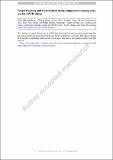| dc.contributor.author | Kwan, Chiman | |
| dc.contributor.author | Chou, Bryan | |
| dc.contributor.author | Yang, Jonathan | |
| dc.contributor.author | Rangamani, Akshay | |
| dc.contributor.author | Tran, Trac | |
| dc.contributor.author | Zhang, Jack | |
| dc.contributor.author | Etienne-Cummings, Ralph | |
| dc.date.accessioned | 2021-09-20T17:30:18Z | |
| dc.date.available | 2021-09-20T17:30:18Z | |
| dc.date.issued | 2019-06-07 | |
| dc.identifier.uri | https://hdl.handle.net/1721.1/131796 | |
| dc.description.abstract | Abstract
The pixel-wise code exposure (PCE) camera is a compressive sensing camera that has several advantages, such as low power consumption and high compression ratio. Moreover, one notable advantage is the capability to control individual pixel exposure time. Conventional approaches of using PCE cameras involve a time-consuming and lossy process to reconstruct the original frames and then use those frames for target tracking and classification. Otherwise, conventional approaches will fail if compressive measurements are used. In this paper, we present a deep learning approach that directly performs target tracking and classification in the compressive measurement domain without any frame reconstruction. Our approach has two parts: tracking and classification. The tracking has been done via detection using You Only Look Once (YOLO), and the classification is achieved using residual network (ResNet). Extensive simulations using short-wave infrared (SWIR) videos demonstrated the efficacy of our proposed approach. | en_US |
| dc.publisher | Springer London | en_US |
| dc.relation.isversionof | https://doi.org/10.1007/s11760-019-01506-4 | en_US |
| dc.rights | Article is made available in accordance with the publisher's policy and may be subject to US copyright law. Please refer to the publisher's site for terms of use. | en_US |
| dc.source | Springer London | en_US |
| dc.title | Target tracking and classification using compressive sensing camera for SWIR videos | en_US |
| dc.type | Article | en_US |
| dc.contributor.department | Massachusetts Institute of Technology. Department of Brain and Cognitive Sciences | |
| dc.eprint.version | Author's final manuscript | en_US |
| dc.type.uri | http://purl.org/eprint/type/JournalArticle | en_US |
| eprint.status | http://purl.org/eprint/status/PeerReviewed | en_US |
| dc.date.updated | 2020-09-24T20:42:19Z | |
| dc.language.rfc3066 | en | |
| dc.rights.holder | Springer-Verlag London Ltd., part of Springer Nature | |
| dspace.embargo.terms | Y | |
| dspace.date.submission | 2020-09-24T20:42:19Z | |
| mit.license | PUBLISHER_POLICY | |
| mit.metadata.status | Authority Work and Publication Information Needed | |
